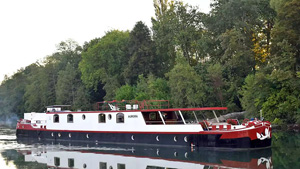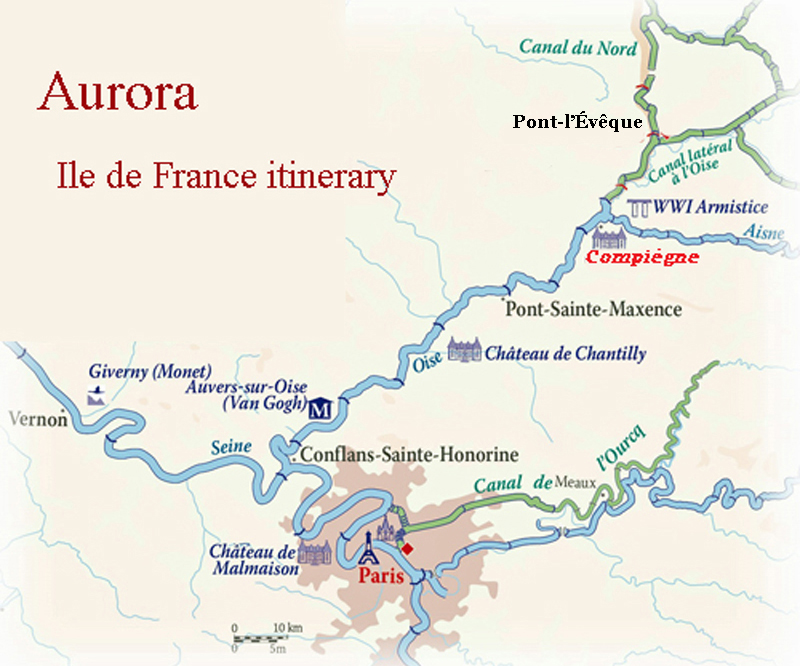Barging in France: Ile de France
Seine & Oise River Cruise Between Paris (Bougival) and Compiègne
Enjoy a river cruise on the Seine and Oise rivers between Compiègne and Paris (Bougival), in the Ile de France. Each day aboard the beautiful Barge Aurora will be a fabulous mixture of relaxation and exploration, with a range of excursions for you to choose from.
Sunday, Day 1 - Paris to mooring at Compiègne
We meet at the airport or your hotel in Paris and travel by private motor coach to Compiegne on the river Oise, where you will board Aurora for a welcome reception with Champagne and petits fours, followed by a short walk around the town of Compiègne before dinner.
Monday, Day 2 - Compiègne to Pont-Ste-Maxence
Choose from the list of possible excursions::
- Château de Compiègne: Built by Louis XV and Louis XVI, and remodelled by both Napoléon I and Napoléon III, the Château de Compiègne was a center for court life and the exercise of power. The originality and beauty of this neo-classical palace and the quality of its interior décor and furnishings make for a unique ensemble. Alongside Versailles and Fontainebleau, this historic site is one of the three largest royal and imperial residences in France.
- Rethondes: This is where a defeated Germany signed the Armistice in a railway carriage on November 11, 1918 ending World War One in Europe. Later, on June 22, 1940, the signing of the Franco-German Armistice took place in this same railway carriage. In fact, Adolph Hitler had the railway wagon removed from the memorial building and put on the tracks at the exact same spot it had been in 1918. He inspected the French monuments at the site and had them covered up. After the Armistice, he even had most of the monuments removed and the railway wagon taken away to Germany, where it was eventually destroyed.
- Château de Pierrefonds: Erected in the late 14th century by Duke Louis of Orléans, the château was taken down in the 17th century and was in ruins when Napoléon III decided to commission architect Eugène Viollet-le-Duc to rebuild it. He applied his architectural designs to create the ideal château, such as would have existed in the Middle Ages. It is situated in a lovely village in the heart of the Compiègne forest.
Tuesday, Day 3 - Pont-Ste-Maxence to St-Leu-d'Esserent
- Visit Senlis, a magnificent romantic medieval town with many old cobbled streets and picturesque houses. Admire the Gothic architecture of the Cathedral Notre-Dame whose first stone was laid over 870 years ago. The Senlis Museum of Art and Archeology is located in the historic center of the town of Senlis, close to Senlis Cathedral. It is located in the ancient episcopal palace of the city, classified historical monument since 1964, and hosts a collection of fine arts.
- Abbey of Royaumont: The Cistercian Royaumont Abbey was founded in 1228 by Louis IX (the future Saint Louis) with the support of his mother, Blanche de Castille. Royaumont has led several lives, first as a Cistercian monastery, then successively as a royal abbey, a cotton mill, a novitiate, a military hospital, and a country home. It has never been left unoccupied. A reflecting canal and a tree-lined avenue mark the entrance to Royaumont Abbey, a monument of timeless beauty nestled in a tranquil setting. The impressive cloister and buildings give a good idea of the prosperity of the monks in the middle ages.
Wednesday, Day 4 - St-Leu-d'Esserent to L'Isle-Adam,
Aurora continues along the Oise River to the charming, picturesque village of L'Isle-Adam, a favorite spot for Parisians wishing to escape the capital for a peaceful weekend. There are many options for today:
- L'Isle-Adam: Take time to explore the town. Visit St Martin's Church is a Catholic parish church, built between 1487 and 1567 in the Renaissance style. The Musée Louis Senlecq boasts a fine collection of works painted by members of the École des bords de l’Oise (Oise Riverbanks School) and displays the art and the history of the district. Musée d'Art et d'Histoire Louis-Senlecq celebrates the art of this painter and photographer. Enjoy an 18th-century English-Chinese garden at the Chinese Pavilion of Cassan was built between 1781 and 1785.
- Méru: Visit the Musée de la Nacre (mother of pearl) et de la Tabletterie. This museum reflects a whole section of local history. From the 17th century, they manufactured fan frames, cane heads, billiard balls, cases, cutlery handles, rosaries as well as small objects and tablets made from horns, bones, and ivory. In the 19th century, a true industry developed and the region became the French capital of manufacturing sets of dominoes, brushes, tokens of piano keys, and mother of pearl buttons.
- Château de Chantilly: This historic French château comprises two attached buildings. The Petit Château was built around 1560 for Anne de Montmorency. The Grand Château was destroyed during the French Revolution and rebuilt in the 1870s. The Château's art gallery, the Musée Condé, houses one of the finest collections of paintings in France, specializing in French paintings and book illuminations of the 15th and 16th centuries. Enjoy the Château and its rich collections, the Apartments of Le Grand Condé, the park & vegetable garden, and the Great Stables.
Thursday, Day 5 - L’Isle-Adam to Conflans-St.Honorine
Today, you may choose between impresionniste art or the history of Absinthe liquor:
- Auvers sur Oise: For the art lovers, Aurora offers a trip to this pleasant village where many impressionists were inspired, including Renoir, Monet, Pissaro and Cezanne. The highlight of the day will be a visit to the house of Van Gogh, where the famous painter lived and died. The chateau-museum includes exhibits to show the décor and life in Paris during this fascinating period of the impressionists.
- Musée de l’Absinthe: Absinthe is an anise-flavored spirit derived from several plants, including the flowers and leaves of Artemisia absinthium ("grand wormwood"), together with green anise, sweet fennel, and other medicinal and culinary herbs. The Museum of Absinthe recreates the atmosphere of a typical Belle Époque café in which absinthe became the drink of choice for poets and artists. To help explain absinthe’s importance in 19th-century French social and cultural life, a unique collection of objects required for its ritual consumption are displayed, along with drawings from the press, etchings and paintings illustrating the “Fée verte” (or “Green Fairy”), as the formidable tipple was nicknamed by its consumers.
Friday, Day 6 - Conflans-Sainte Honorine to Bougival
Aurora continues the barge cruise along the Seine River. During the cruise one can admire many fine houses perched along the river. After the lunch we can visit either:
Château de Malmaison: Château de Malmaison is a beautiful palace a few miles west of Paris in the town of Rueil-Malmaison. It was once home to Joséphine & Napoléon Bonaparte, and was briefly the seat of the French government. Before going to Egypt in 1798, Napoléon I gave his wife Joséphine the task of finding a country house to her liking. It was a delapitated house from the 17th century situated on nearly 150 acres of woods and meadows. Upon Napoléon's return, renovations by architects Percier and Fontaine (1800 to 1802) turned it into a luxurious villa with all the fashions of the 19th century.
She endeavored to transform the large estate into "the most beautiful and curious garden in Europe, a model of good cultivation". Two hundred plants, such as purple magnolia, tree peony, hibiscus, camellias, and dahlias, were grown in France for the first time at Malmaison. The property was famous for its rose garden with more than 250 varieties of roses. Birds and animals of all sorts were allowed to roam free among the grounds. Among these were kangaroos, emus, black swans, zebras, sheep, gazelles, ostriches, chamois, a seal, antelopes and llamas, to name a few.
The Bonapartes were unable to have children so Napoléon, desperate for an heir, divorced Joséphine in 1809. He insisted she keep her title and he gave her Malmaison along with a pension of 5 million francs per year. She lived at the château until her death in 1814.
After his defeat at the Battle of Waterloo (1815), Napoléon returned and took residence in the house before his exile to the island of Saint Helena. More history follows, which you will learn more about on your excursion.
- Visit the City of Lights in half a day: Enjoy a whirlwind tour of Paris in the minibus with brief stops at the main sights: the Eiffel tower, Musee d’Orsay, Notre Dame Cathedral, Louvre Museum, the Arc de Triomphe, Trocadeéo, Montmartre, and Sacre Coeur Basilica.
Saturday, Day 7 - Bougival - Return to Paris
Breakfast on board followed by a late morning return to Paris (hotels or airport) by private minibus.
NOTE: This is a sample itinerary. Excursions are tailor-made to suit your interests.
HOME > ITINERARIES > FRANCE: Compiègne to Paris (Bougival)

